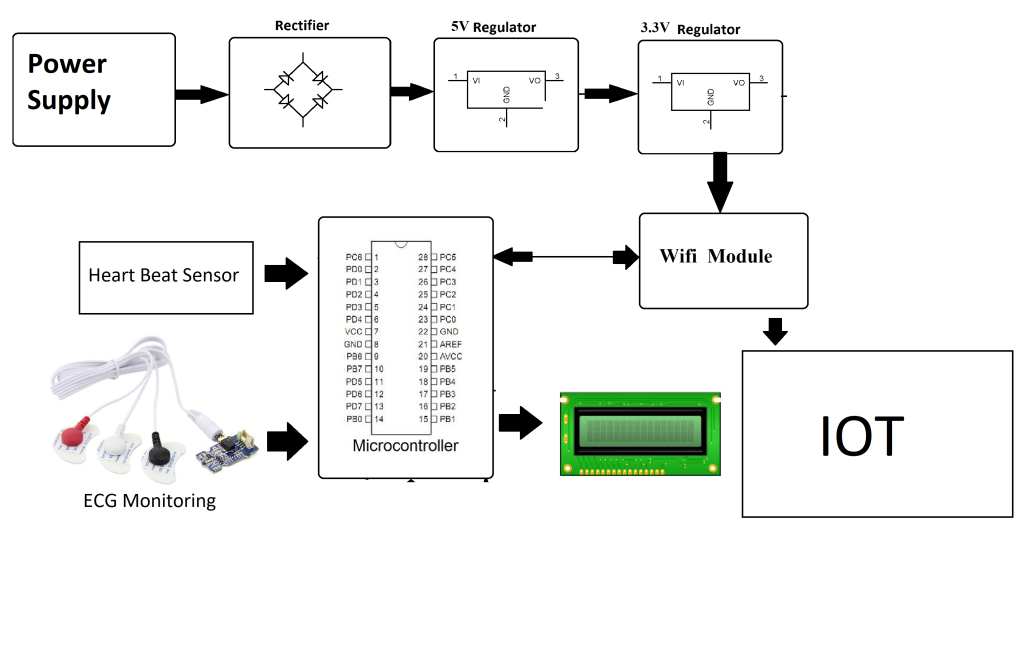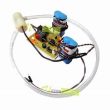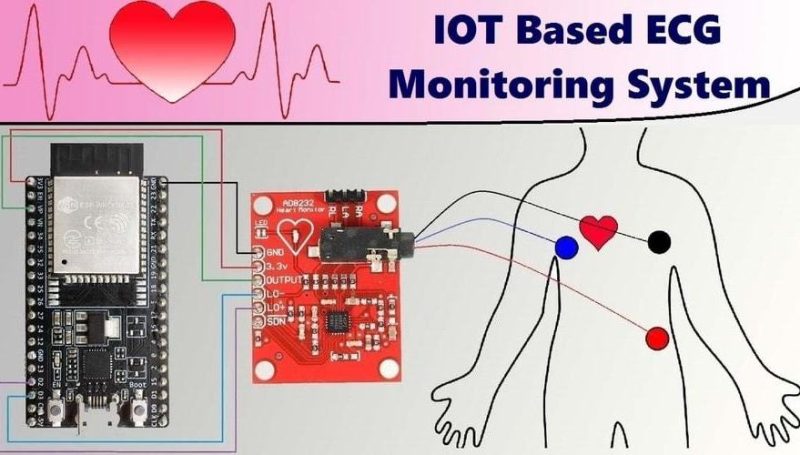Introduction
Embedded technology has revolutionized various aspects of life, including the healthcare industry. The demand for smart, connected health solutions is growing as people are becoming more health-conscious yet unaware of their latent health issues. One vital area where embedded technology and the Internet of Things (IoT) are making significant advancements is heart health monitoring, particularly through the use of ECG (Electrocardiogram) sensors. With heart disease being one of the leading causes of death globally, having a real-time heart monitoring system can be a lifesaver. This IoT-based heart monitoring system uses an ECG sensor to help individuals monitor their heart conditions and detect potential heart diseases early.
What is an ECG and Why is it Important?
An ECG, or Electrocardiogram, is a non-invasive test that records the electrical activity of the heart over a period of time. It provides critical data that can help diagnose various heart conditions such as arrhythmias, coronary artery disease, and heart attacks. The ECG signal shows how the heart is beating and whether there are any irregularities in its rhythm. By analyzing the ECG waveform, healthcare professionals can detect abnormalities, helping to prevent severe cardiac events.
Understanding the IoT-Based Heart Monitoring System
The IoT-based heart monitoring system integrates traditional ECG monitoring with the power of IoT technology. Through IoT, real-time heart data can be transmitted wirelessly to a smartphone or a hospital’s database, making the system more accessible and efficient. The integration of IoT allows for continuous monitoring, ensuring that heart issues can be detected early and managed proactively. Furthermore, if any abnormalities are detected, an alert is automatically sent to the patient or healthcare provider, enabling timely medical intervention.
System Components and Architecture
At the heart of this system is an AVR microcontroller that processes the ECG data and communicates it through a Wi-Fi module. The system also includes an ECG sensor that monitors the heart’s electrical signals. When the ECG sensor detects abnormal signals, the controller identifies these irregularities and sends the result over IoT. The overall architecture is designed to be robust yet energy-efficient, making it ideal for both home use and hospital environments.

Hardware Specifications of the System
Let’s take a closer look at the hardware components:
AVR Microcontroller
The AVR microcontroller acts as the brain of the system. It collects and processes the data from the ECG sensor and ensures real-time transmission of data via the Wi-Fi module.
Wi-Fi Module
The Wi-Fi module is crucial for transmitting heart data wirelessly. This enables remote monitoring by sending real-time ECG data to a healthcare provider’s server or the patient’s smartphone.
ECG Sensor
The ECG sensor monitors the electrical signals produced by the heart. It is a sensitive device that picks up the slightest changes in heart rhythm and transmits this data to the AVR microcontroller.
Crystal Oscillator
The crystal oscillator ensures that the microcontroller operates at a stable frequency, which is essential for accurate ECG readings and signal processing.
LCD Display
The LCD display provides real-time feedback by showing the patient’s heartbeat rate and ECG data on the screen. This helps users monitor their heart health without needing complex devices.
Additional Hardware Components
Other essential components include resistors, capacitors, transistors, diodes, and LEDs. Each plays a role in signal processing and power management. Cables and connectors are used for linking various components, and a transformer supplies the necessary power.
Software Specifications
Arduino Compiler
The Arduino compiler is used to program the microcontroller. It compiles the code, allowing the microcontroller to interact with hardware components, process ECG signals, and communicate data over IoT.
Programming Language: C
C programming language is preferred due to its efficiency and control over hardware. It allows developers to write low-level code optimized for embedded systems, ensuring the system runs smoothly with minimal resources.
How the ECG Heart Monitoring System Works
The system’s operation starts with the ECG sensor capturing the heart’s electrical activity. This data is then sent to the AVR microcontroller, which scans the signal and compares it with predefined heart rhythm patterns. If the signal falls within the normal range, the system reports that the heart is functioning normally. If any abnormalities are detected, the system flags the issue, indicating the person might have a heart condition. The detected data is then transmitted via the Wi-Fi module to an external device like a smartphone or a medical server.
Role of the ATmega Controller
The ATmega microcontroller is vital for processing the ECG signals and checking them against predefined parameters. It scans the incoming signals from the ECG sensor, and if it detects a deviation from the common range, it categorizes the heart condition as abnormal. This data is then compiled into a report that either indicates normal heart health or flags potential issues.
Data Transmission Over IoT
Once the microcontroller processes the ECG data, it sends the results over IoT using the Wi-Fi module. This data can be accessed remotely by healthcare professionals or the patient themselves. If an abnormal condition is detected, a warning message can be sent instantly via IoT, ensuring timely medical action.
Advantages of IoT-Based Heart Monitoring Systems
One of the biggest advantages of an IoT-based heart monitoring system is its ability to provide continuous, real-time monitoring. This ensures that any abnormalities are detected early, reducing the risk of heart attacks or other severe conditions. Remote monitoring also allows patients to stay at home while doctors receive updates, reducing hospital visits. Additionally, the system can store historical data for future analysis, providing doctors with valuable insights into a patient’s long-term heart health.
Challenges and Limitations of the System
Despite its benefits, the system faces certain challenges. Signal interference from external devices can affect the accuracy of ECG readings. Additionally, transmitting sensitive medical data over the internet raises concerns about privacy and security. The system’s continuous monitoring can also lead to higher power consumption, making it essential to have a reliable power source.
Applications of the System in Healthcare
The IoT-based ECG heart monitoring system can be used in hospitals, diagnostic centers, and even in-home care. It is especially useful for monitoring elderly patients or those with chronic heart conditions who require constant supervision. Emergency medical services can also use this system for real-time heart monitoring during transport to hospitals.
Future Scope and Developments
The future of IoT-based heart monitoring systems looks promising. AI and machine learning can be incorporated to enhance the accuracy of heart condition predictions. Integration with other wearable devices like smartwatches and fitness trackers can provide a more holistic view of a person’s health. Moreover, future developments will likely focus on improving data security to protect sensitive medical information.
References
1. Research Papers & Journals
- “Internet of Things for Healthcare: A Comprehensive Survey” – Provides an overview of IoT applications in healthcare, including heart monitoring systems.
- Link: IEEE Xplore (https://ieeexplore.ieee.org/)
- “A Review of ECG Signal Processing Techniques for Wearable Devices” – Discusses various techniques for ECG signal processing used in wearable heart monitoring devices.
- Link: ScienceDirect (https://www.sciencedirect.com/)
- “Design and Implementation of IoT-Based Real-Time ECG Monitoring System” – A detailed case study on how to develop an ECG monitoring system using IoT.
- Link: ResearchGate (https://www.researchgate.net/)
2. Websites and Blogs
- Arduino Official Website – Offers tutorials and resources for programming microcontrollers like ATmega, commonly used in IoT-based health monitoring systems.
- Link: https://www.arduino.cc/
- Texas Instruments – Provides resources for building ECG systems and insights into medical-grade embedded systems.
- Link: https://www.ti.com/
- All About Circuits – Contains articles and forums about designing and building IoT-enabled medical devices, including ECG systems.
3. Books
- “Practical IoT for Healthcare” by Fadi Al-Turjman – A practical guide to designing IoT-based healthcare applications, including heart monitoring systems.
- “Biomedical Signal Processing” by Rangaraj M. Rangayyan – Discusses signal processing techniques relevant to ECG data and health monitoring.
4. Tutorials & Online Courses
Link: https://www.udemy.com/
Coursera – Offers courses on IoT in healthcare, embedded systems, and medical device development.
Link: https://www.coursera.org/
Udemy – IoT and embedded systems courses that teach the practical implementation of health monitoring systems using ECG.








